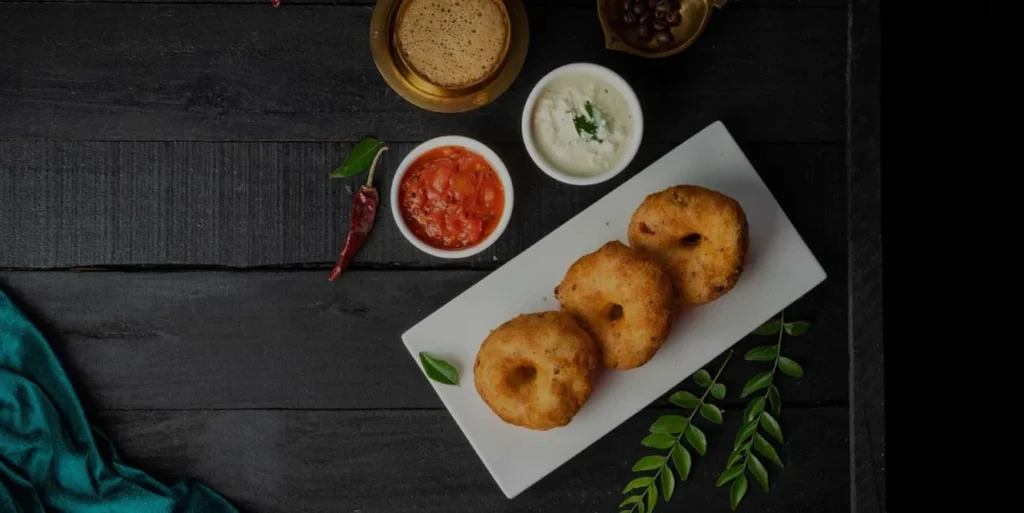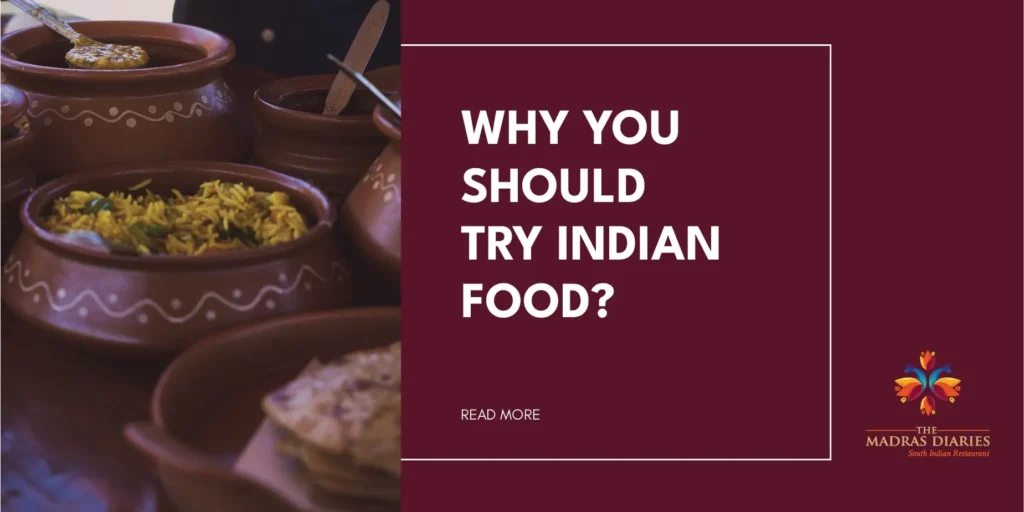When you think of Indian food, chances are your mind first wanders to butter chicken and naan. But, there is a whole other side to Indian cuisine that is bursting with flavours, colours and traditions older than time itself.
South Indian food stands out for its simplicity, bold taste and deep-rooted connection to tradition. It uses everyday ingredients and spices to create dishes that are comforting and incredibly satisfying.
So, let’s take a closer look at this beautifully rustic and complex cuisine.
What Is It About South Indian Food That Feels Special?
Rooted Deep In Tradition
One of the biggest secrets behind the magic of South Indian food is its deep connection with tradition.
This is not a cuisine that came into existence overnight. It is the result of centuries – yes, centuries – of fine-tuning, experimenting and passing down recipes.
From the Tamil Brahmin kitchens to the royal palaces of Karnataka, every region has added its own spin.
And yet, there is a certain invisible thread that ties it all together – a strong belief in honouring ingredients, respecting seasons and cooking with care. Food here is a way of life.
You will hear grandmothers proudly declaring that no store-bought masala can beat the one they have roasted and ground by hand. And honestly, after one taste, you will agree with them.
Simplicity For The Win
In a world where ‘more’ is often mistaken for ‘better,’ South Indian food sticks to a different philosophy: let the ingredients shine.
Take the humble dosa, for example. Just fermented rice and lentils, right? But bite into a perfectly crisp dosa with a Sambar and tell us it is not a flavourful ride in your mouth.
It is this commitment to simplicity, without ever being bland, that makes South Indian food stand head and shoulders above the rest.
The Art Of Fermentation
If you think fermentation is just some fancy health trend, South India would like a word. Long before gut health became a buzzword, South Indians were soaking, grinding and fermenting batters for Idli and Dosa like it was second nature.
Fermentation is not just about taste – though trust us, the slight tang in a good idli is pure joy – it is also about nutrition. This slow, natural process unlocks nutrients, makes digestion easy and keeps your tummy happy.
And here’s the astonishing part: there is no stopwatch ticking down fermentation times in these kitchens. It is all about reading the signs – the feel of the batter, the smell in the air, the temperature outside. Cooking is intuitive in this cuisine.
Rich Diversity
Saying ‘South Indian food’ is almost like saying ‘European food’ – it barely scratches the surface. South India is a vast land of cultures, languages, landscapes and yes, foods.
In Tamil Nadu, you will find robust Chettinad gravies that pack a punch. In Kerala, it is all about mellow coconut-based curries and banana leaf feasts that feel almost spiritual.
Karnataka offers everything from decadent Mysore Masala Dosas to delicate Mangalorean Fish Curries. And, Andhra Pradesh? Hold onto your glasses of water – those fiery pickles and spicy biryanis are not for the faint-hearted!
Even within each state, every district and every village seems to have its own spin. The same Dosa you bite into in Chennai will taste worlds apart from one in Mangalore.
It is definitely about food, but it is also about storytelling, with each dish revealing something about the people, the soil and the soul of the place.
Rice-based Dishes
Unlike other parts of India where wheat-based dishes like Roti and Naan dominate, this cuisine is built around rice. It is the backbone of almost every meal, be it served plain, fried or in the form of batter.
The meals revolve around a heaping serving of rice, accompanied by various side dishes. The cultural significance of rice is also immense – it is a symbol of prosperity and life itself. This is why rice is treated with such reverence in households.
South India is also home to different varieties of rice, each contributing its own unique texture and flavour to the dish.
For example, the aromatic Basmati Rice is a common choice for making Pulao or Biryani, while the sticky and soft variety of rice is used for making Idlis and Dosas.
A Paradise For All Food Lovers
If you are someone who swoons over vegetarian dishes, South Indian cuisine is a treasure chest.
Be it a lips-smacking Avial brimming with seasonal vegetables or a crisp Masala Dosa oozing with spiced potatoes, the admiration for veggies is deep and abiding.
It is no small feat to make a simple cucumber salad (Kosambari) taste divine, but South Indian cooks manage it with a sprinkle of grated coconut, a tempering of mustard seeds and a lot of heart.
But no, South India does not just have a vegetarian stronghold. Meat and seafood have their rightful, glorious place too.
The fiery Chettinad Chicken, the peppery Andhra Mutton Curry, the tantalising Kerala Fish Moilee – they are all proof that South Indian kitchens know their way around meat just as well as they do vegetables.
Heaven Of Spices
Spices are the soul of South Indian cuisine and their use goes beyond simply adding flavour. It creates balance, depth and a multi-layered experience that captures your palate.
The South Indian spice box typically includes staples like mustard seeds, cumin, coriander and black pepper, among others. It is also interesting to know how spices are tempered in South Indian food.
Spices add a whole new dimension to every dish, making it taste comforting and exotic all at once.
Breakfast Like Royalty
If you ever need a reason to set an early alarm, South Indian breakfasts are it. Where else can you feast on a spread that includes Dosa, Idli, Upma, Pongal, Vada and Appam – all before noon?
In many South Indian homes, breakfast is the main event of the day and it is taken very seriously. It is hearty, wholesome and made with attention to detail.
Health On A Plate
South Indian cuisine often uses lentils and legumes like toor dal, moong dal and chana dal, all of which are rich in protein, fibre and essential nutrients.
Many dishes are naturally gluten-free, as they are primarily rice or lentil-based and they are typically low in fat.
The use of fresh vegetables, leafy greens and a variety of herbs like curry leaves and mint also boosts the health quotient of South Indian food.
Curry leaves, for instance, are known for their antioxidant properties and are often included in cooking for their health benefits. Similarly, tamarind, frequently used in Sambars and Rasams, is rich in vitamin C and antioxidants.
Add to that the use of coconut oil in many dishes, known for its medium-chain fatty acids that are good for metabolism and you have a cuisine that is as nourishing and delectable.
Food As Celebration
South Indian festivals are not just about rituals – they focus on food and lots of it. Whether it is Pongal, Onam, Ugadi, Vishu or Navaratri, every festival comes with its own signature dishes that have been lovingly preserved through generations.
Speaking of celebration, have you ever experienced a feast from Kerala, the traditional Sadhya? If not, add it to your bucket list right now.
A banana leaf will be laid out in front of you and then dish after dish (more than 20) are lovingly ladled onto it. It is an explosion of colours, textures and flavours.
Pongal festival would not be complete without the sweet, ghee-dripping happiness of Sakkarai Pongal.
Ugadi brings the unique Ugadi Pachadi – a dish that blends six tastes representing different emotions, reminding us that life is a beautiful (and sometimes messy) mix of everything.
Scrumptious Street Food
Now, let’s not forget the fun stuff – street foods! From Chennai’s iconic murukku sandwiches (yes, you read that right) to Mysore’s piping hot Bonda to Kerala’s Pazham Pori (sweet banana fritters), South Indian street food is drool-worthy.
Food carts and tiny shops, often no more than a shack with a stove, attract long queues. Why? Because locals know where the good stuff is.
There is a raw, honest energy to South Indian street food that you just can’t find elsewhere.
So, had you been circling the idea of trying South Indian food, let us be the nudge you needed. Go on, book that table at the neighbourhood South Indian spot.
And, if you are in Amsterdam or Utrecht, you are in luck. There is a little slice of South Indian wonder in The Madras Diaries.
We are not going to spill all the beans about the food here because, honestly, some experiences are too good to be explained with just words.
Step in, taste the food, enjoy the vibe – you will know exactly what we mean. Happy eating!



